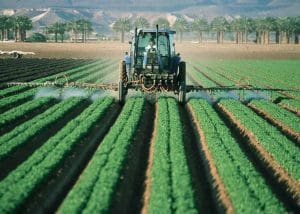Today’s increasingly green population has become hyper-sensitive to potential pollution, possible pesticides and furious fertilisation. Your average 21st century consumer cares about ensuring that nothing has been sprayed on their lettuce except their own dressing of choice.
In the immortal words of Joni Mitchel –
“I don’t care about spots on my apples; leave me the birds and the bees”.
Today, consumers want fresh, organic, natural produce and they want nature to be unscathed for tomorrow. So, how to you deliver this to the public? Is it possible to produce crops with little to no impact on the environment? And, most importantly, is it sustainable for a business?
Pesticides

The first and most common “pollutant” that consumers want to see less of is pesticides. Whilst the extent of pesticide’s pollution is not entirely understood, it’s at least understood that certain pesticides have negative effects on pollinator populations – the same pollinators which we rely on in agriculture.
People want to see produce that’s not been sprayed with pesticides, or at very least, produce free from known pesticides which harm the environment. Increasingly, consumers are looking toward biopesticide use. That is, pesticides made from purely natural products such as other animals, plants, microorganisms and minerals.
Whilst there are still concerns and lack of research on some biopesticide’s effects on non-target species, they are widely regarded as less harmful and have fewer environmental effects than pesticides.
Fertilisers

As mentioned in our recent blog “Fertiliser vs Compost”, fertilisers can have a negative effect on the environment. The abundance of “readily available” nitrogen, as well as phosphorus and potassium, means that it’s easily leeched from the soil through heavy rain and a high water-table. This induces higher levels of Nitrogen and Phosphorus in the surrounding water.
A high level of fertiliser run-off is attributed to algal blooms in nearby water. These algae blooms produce toxins which are dangerous to humans and wildlife, increases the costs of water treatment and creates an uninhabitable environment for fish and other wildlife. This creates a knock-on effect in the environment with an exponential increase in toxins and nitrogen being introduced to the water through decaying matter.
This is why many farms are turning to using regular compost and digestate applications instead of fertiliser. Compost offers many of the same benefits, without the potential damages. Take a look at our blog “fertiliser vs compost” on how compost can be used to improve agricultural returns.
Land management

It’s a little known fact that how you manage your agricultural land can and will play a large part in your agricultural pollution levels. There is a natural process within soil known as the “biogeochemical process”, which results in the emission of various greenhouse gases – It’s a natural process that happens everywhere.
However, tillage of the land can increase these pollution levels by allowing trapped gasses to escape. Whilst tilling is a necessity of agriculture, over tilling can harm the environment by releasing greenhouse gases and destroy your farm’s soil quality. Take a look at our recent blog “How to manage agricultural soil quality” to learn more about how tilling (and other things) can ruin your farm’s soil quality and potential returns.
